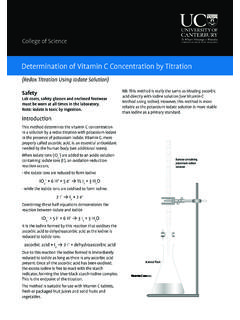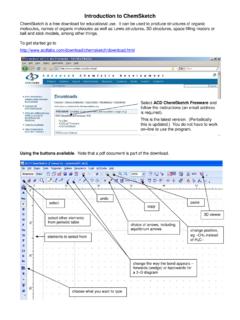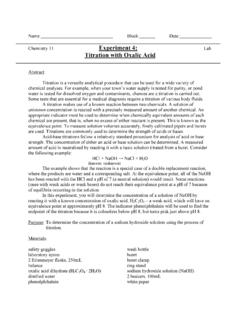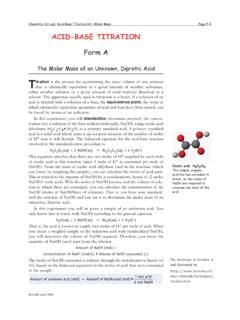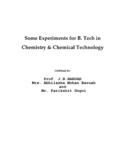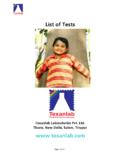Transcription of Determination of Vitamin C Concentration by …
1 College of Science Determination of Vitamin C Concentration by Titration (Redox Titration Using Iodine Solution). Safety Solutions Needed Lab coats, safety glasses and enclosed footwear must Iodine solution: ( mol L 1). Weigh 2 g of potassium be worn at all times in the laboratory. iodide into a 100 mL beaker. Weigh g of iodine and add it into the same beaker. Add a few mL of distilled Introduction water and swirl for a few minutes until iodine is dissolved. Transfer iodine solution to a 1 L volumetric This method determines the Vitamin C Concentration flask, making sure to rinse all traces of solution into the in a solution by a redox titration using iodine. Vitamin volumetric flask using distilled water. Make the solution C, more properly called ascorbic acid, is an essential Determination of Vitamin C Concentration antioxidant needed by the human body (see additional up to the 1 L mark with distilled water.)
2 Starch indicator solution: ( ). Weigh g of by Titration notes). As the iodine is added during the titration, the ascorbic acid is oxidised to dehydroascorbic acid, while soluble starch and add it to 50 mL of near boiling water (Redox the iodine is reduced to iodide ions. Using Iodine Solution)in a 100 mL conical flask. Stir to dissolve and cool before Titration using. ascorbic acid + I2 2 I . +. Introduction dehydroascorbic acid Due to this reaction, the Thisiodine formed istheimmediately method determines Vitamin C Concentration in a solution by a redox titration using iodine. Vitamin reduced to iodide as long as there is any ascorbic acid C, more properly called ascorbic acid, is an essential Burette containing present. Once all the ascorbic antioxidantacid neededhas been by the humanoxidised, body (see additional iodine solution the excess iodine is free to react notes).
3 With isthe As the iodine starch added during the titration, the indicator, forming theascorbic acid is oxidised to dehydroascorbic acid, while blue-black starch-iodine complex. the iodine is reduced to iodide ions. This is the endpoint of the titration. ascorbic acid + I2 2 I + dehydroascorbic acid . The method is suitableDuefortouse with Vitamin this reaction, the iodineCformed tablets, is immediately fresh or packaged fruitreduced juicestoand iodidesolid fruits as long and as there is any ascorbic acid vegetables. present. Once all the ascorbic acid has been oxidised, the excess iodine is free to react with the starch NB: This method is more straight indicator, formingforward thanstarch-iodine the blue-black the complex. This is the endpoint of the alternative method using potassium iodate, but as titration.
4 The potassium iodate The method is solution is suitable more for use with stable thanvitamin theC tablets, fresh or packaged fruit juices and solid fruits and iodine as a primary standard, alternative method is more reliable. NB: This method is more straight forward than the alternative method using potassium iodate, but as the potassium iodate solution is more stable than the Equipment Needed iodine as a primary standard, the alternative method is more reliable. burette and stand Conical flask 100 mL or 200 mL volumetric flaskNeeded Equipment 20 mL pipette burette and stand Vitamin C sample solution 100 mL or 200 mL volumetric flask 10 mL and 100 mL measuring cylinders 20 mL pipette 250 mL conical flasks 10 mL and 100 mL measuring cylinders 250 mL conical flasks Solutions Needed Iodine solution: ( mol L 1).
5 Weigh 2 g of potassium Method 4. Calculate the Concentration in mol L 1 of ascorbic acid in the solution obtained from fruit/vegetable/. Sample StarchPreparation indicator solution: ( ). Weigh g of Also, the equation calculate the of the titration (below). Concentration , in mg/100mL. soluble starch and add it to 50 mL of near For Vitamin C tablets: Dissolve a single tablet in 200 mL boiling water determine or mg/100g of ascorbic acid, in the sampleacid the number of moles of ascorbic of fruit/. in a 100 mL conical flask. Stir to dissolve of distilled water (in a volumetric flask if possible). and cool before reacting. vegetable/juice. using. For fresh fruit juice: Strain the juice through ascorbic acid + I2 2 I + dehydroascorbic acid cheesecloth to remove seeds and pulp which may block Additional Notes 4.
6 Calculate the Concentration in mol L 1 of ascorbic Method pipettes. 1. acid Iodine stains in the both skin solution and clothing obtained so proper care is from fruit/vegetable/juice. ForSample packaged fruit juice: This may also need to be Preparation advised. Also, If staining calculate does occur, alcohol the Concentration , may remove in mg/100mL or mg/. strained through cheesecloth if it contains a lot of pulp skin stains and cleaners are available for 100g of ascorbic acid in the sample of fruit/vegetable/ fabric stains. For or seeds. Vitamin C tablets: Dissolve a single tablet in 200 mL. of distilled water (in a volumetric flask if possible). 2. juice. Vitamin C, or ascorbic acid, is a water soluble For fruits and vegetables: Cut a 100 g sample into small antioxidant that plays a vital role in protecting the For fresh fruit in juice: Strainand the juice through Add 10cheese pieces cloth and grind to remove a mortar seeds and pulp pestle.
7 Which may mL. block Additional Notesand disease. It is not synthesised body from infection portions of distilled water several times while grinding by the human body and therefore must be thepipettes. sample, each time decanting off the liquid extract Iodine stains from bothsources dietary skin and clothing primarilysofruits properandcare intoFora 100 mL volumetric flask. is advised. If staining does occur, alcohol vegetables. The chemical structure and antioxidant may remove packaged fruit juice: ThisFinally, may alsostrain need the toground be fruit/vegetable pulp through cheesecloth, rinsing the skin stains and (reducing) cleaners action are available of ascorbic acid arefor fabric stains. illustrated in strained through cheese cloth if it contains a lot of pulp pulpor with seeds.
8 A few 10 mL portions of water and collecting the redox 2. halfC,equation Vitamin or ascorbic below: acid, is a water soluble all filtrate and washings in the volumetric flask. Make antioxidant that plays a vital role in protecting the body For fruits and vegetables: Cut a 100 g sample into small 3. The Concentration of the prepared iodine solution the extracted solution up to 100 mL with distilled water. from can be infection and disease. more accurately It is not synthesised determined by titrationby with pieces and grind in a mortar and pestle. Add 10 mL. Alternatively the 100 g sample of fruit or vegetable the a human standard body and solution therefore of ascorbic must acid be or acquired a standard from portions of distilled water several times while grinding may dietary solution sources primarily of potassium fruits andusing thiosulfate vegetables.
9 A starchThe thebesample, blendedeach in atime fooddecanting processoroff together withextract the liquid chemical structure and antioxidant (reducing) action of about into50 mL mL. a 100 of distilled volumetric water. After flask. blending, Finally, the ground indicator. This should be done if possible as iodine strainstrain thefruit/vegetable pulp through cheesecloth, ascorbic solutionsacidcanare beillustrated unstable. in the redox half equation pulp throughwashing it with cheese cloth, a fewthe rinsing 10mL portions of distilled water, and makeand thecollecting extracted below: pulp with a few 10 mL portions of water solution up to 100washings mL in a volumetric flask. flask. Make HO HO. all filtrate and in the volumetric O O. oxidation O O.
10 The extracted solution up to 100 mL with distilled water. HO HO + 2H+ + 2e- reduction Titration Alternatively the 100 g sample of fruit or vegetable may HO OH O O. be blended ascorbic acid dehydroascorbic acid 1. Pipette a 20inmLa food processor aliquot togethersolution of the sample with about into 50 mL of distilled water. After blending, strain a 250 mL conical flask and add about 150 mL of the 3. The Concentration of the prepared iodine solution pulp through distilled watercheese cloth, and 1 mL washing of starch it with asolution. indicator few 10 4. The average titre volume should ideally be in the can be more accurately determined by titration with a mL portions of distilled water, and make the extracted range of 10 30 mL. If the titre required for a 20 mL.
